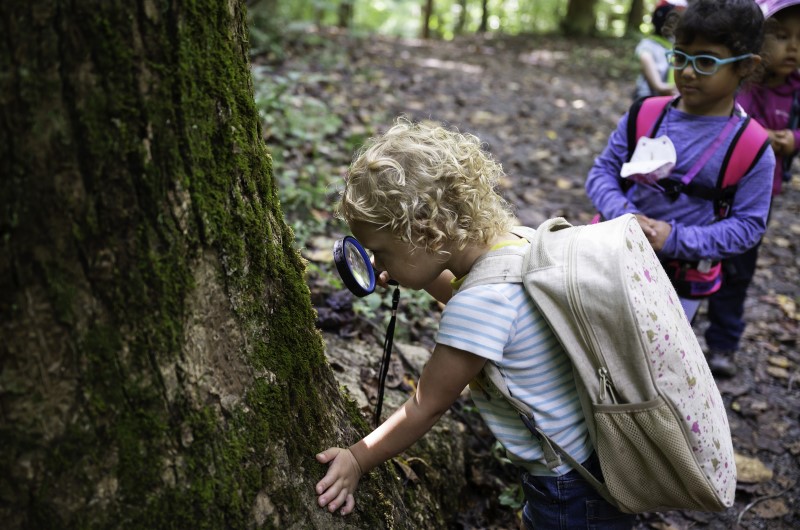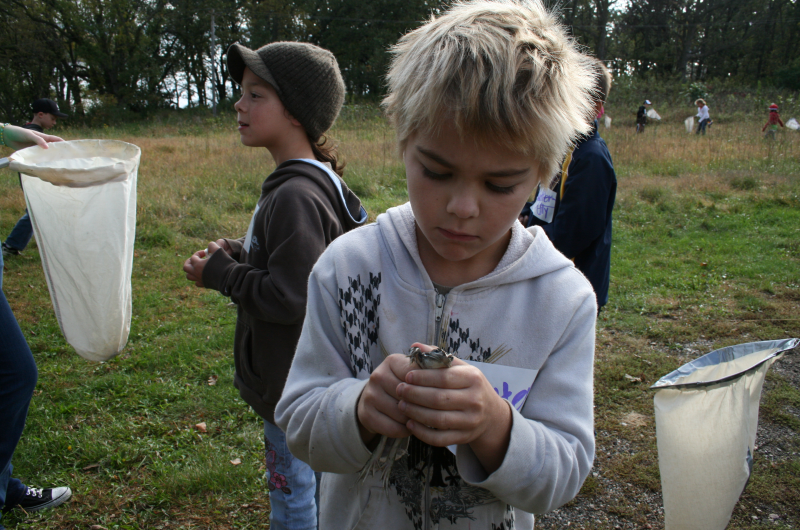Kids these days don’t spend enough time outdoors. Boomer parents have been muttering that for a generation now. A raft of reasons has accrued to explain why kids are not outside as much as they were in previous generations – concerns about
safety, an astronomical amount of screen time, less access to natural areas.
Richard Louv brought this issue into focus in his popular 2005 book, Last Child in the Woods. He coined the term “nature-deficit disorder” to describe the detrimental impact of less time spent outdoors. That’s not a medical
condition, he says, but rather a summation of the “human costs of alienation from nature, among them: diminished use of the senses, attention difficulties, and higher rates of physical and emotional illnesses.”
The solution, Louv argued, is more connections and physical contact with nature. A decade later, Scott D. Sampson published How to Raise a Wild
Child, which provided ideas and tips about how kids can learn through nature, “green schools” and similar programs.
 Getting a closer look at moss at Riverbend Park Forest Preschool.
Getting a closer look at moss at Riverbend Park Forest Preschool.Early outdoors
Start young.
That’s good advice for many pursuits – learning music, eating healthy, staying fit. And appreciating nature. As we have known all along, being outdoors provides countless rewards.
Now, a growing number of educators and researchers report that experiences in nature also open a world of opportunities for development, growth and learning for children.
"Nature is an amazing classroom, and every day you can see something different – especially with the changing seasons."
Recently, schools designed to operate outdoors have popped up throughout the U.S., particularly in preschools, which typically enroll kids in the three-to-five-years age range. The “forest school” concept has been alive and well in Europe
for decades. While some programs in the U.S. are called forest schools, a broader term is outdoor schools or nature-based instruction.
One school in the U.S. has a longer history. Mary Skopec, Ph.D., is executive director of the Iowa Lakeside Laboratory near Milford, Iowa. Skopec also serves as a senior scientist with the Iowa Department of Natural Resources where she coordinates the
IOWATER stream monitoring programs. (Skopec spoke about volunteer science at the League’s
annual convention in 2019.)
Skopec says, “Outdoor-based education is always the best way to learn. We have been doing this type of education since 1909 with college students and since the 1990s, with K-12 students.”
The Lakeside Lab is owned by the state of Iowa and has a 147-acre campus on West Okoboji Lake, which along with natural areas connected to the Lab, serve as outdoor classrooms. Dr. Thomas Macbride and colleagues from the University of Iowa founded the
Lab in 1909 for “the study of nature in nature.”
“We find that students are more focused and engaged when they are outside with hands-on learning models,” says Skopec. “One of my long-term goals is to quantify the effects of this education model on the learner, but we aren’t
quite there yet.”
While it’s hard to nail down a precise cause-effect relationship, researchers have found a clear link between outdoor experiences and learning, as explained in the sidebar below.
 Students examine wildlife at the Iowa Lakeside Laboratory.
Students examine wildlife at the Iowa Lakeside Laboratory.Riverbend Park Forest School
With miles of trails along the Potomac River, covered shelters, a nature center and a long history of education programs, Riverbend Park is a logical location for an outdoor preschool. The park spans 400 acres of woodlands and is one of many parks managed
by the Fairfax County Park Authority in Northern Virginia. The agency decided to establish Riverbend Park Forest Preschool, which was fully licensed and operating in January 2022.
The school has a curriculum planned by the teachers, but the central idea is to let children experience and explore the outdoors and tie learning to their discoveries and interests.
"We work with trees. We breathe what trees give us and they breathe what we give them."– Preschooler in Virginia
“Nature is an amazing classroom,” says Kylie Starck, director of the Riverbend preschool. “Every day you can see something different – especially with the changing seasons. Things that inspire the child inspire the teachers to
learn more, ask questions and build activities around their student’s interests.” In practice, this offers learning opportunities for the teachers and students alike.
Students, age three through five, stay for four hours and are allowed to play in ways that they enjoy – or even “crave,” Starck says. “Kids learn that fun doesn’t require a battery or something you buy in a store.”
As an outdoor school, the children only go inside if the weather is dangerous, so rain and cold weather don’t drive the learning indoors. Many outdoor schools may have a shelter area or a tarp, but no building at all.
The small class size – 12 students and two teachers – means staff can help kids with different needs or learning styles to pursue individual interests. The goal is to instill confidence, competence and social-emotional development in the children.
Do the teachers ever have an “aha moment” with the students? “Every day,” Starck says. She recalls one preschooler’s observation about people and plants: “We work with the trees. We breathe what trees give us and they
breathe what we give them.”
And parents? “Our parents have said that Forest Preschool is ‘magical,’” Starck says.
How Nature-Based Instruction Helps Children Learn
A 2019 review of peer-reviewed research found that experiences in nature improve academic learning, personal development and respect for the natural world.
Frances E. Kuo, Ph.D., associate professor of Natural Resources and Environmental Sciences at the University of Illinois, Urbana-Champaign, was lead author of the paper in Frontiers of Psychology, “Do Experiences with Nature Promote
Learning? Converging Evidence of a Cause-and-Effect Relationship.”
Kuo’s review found evidence that experiences in nature “promote learning by improving learners’ attention, levels of stress, self-discipline, interest and enjoyment in learning and physical activity and fitness.” In fact, her
review found that “in academic contexts, nature-based education outperforms traditional instruction.”
Kuo’s paper outlines eight likely pathways that lead to learning benefits.
- Improved concentration and attention.
- Reduced stress.
- Better self-discipline and impulse control.
- Higher motivation, enjoyment and engagement.
- More physical activity and better fitness.
- Greater calm, less disruptive behavior resulting in a better learning environment.
- Potential to foster warmer, more cooperative relationships with other students.
- Opportunities for more creative, physical and social play.
Kuo tells Outdoor America that exciting results appear in the March 2023 issue of The Journal of Environmental Psychology. The title of the article explains findings of a large-scale study: “School greenspace is associated
with enhanced benefits of academic interventions on annual reading improvement for children of color in California.”
The study, led by Cornell University’s Rouzbeh Rahai, Ph.D., found that the new research “highlights how nature can help bolster academic outcomes for youth who need the most support: low-income children of color.”
Filling a need
For some parents, getting kids enrolled in a preschool or childcare program is akin to getting into an exclusive college. And it’s easy to spend a small fortune for the privilege.
Even before the pandemic, it was a challenge to find staff to work in preschools. The nonprofit Child Care Aware says COVID caused 16,000 preschools to close.
So some educators view outdoor preschools as a way to help meet this enormous demand.
Monica Wiedel-Lubinski, M.Ed., established three nature-based preschool programs in Maryland and founded the Eastern Region Association of Forest and Nature Schools, where she serves as executive director.
"Kids learn that fun doesn't require a battery or something you buy in a store."
She cites the different pathways to learning in nature preschools identified by Frances E. Kuo, Ph.D., whose 2019 survey of the research found that “nature-based education outperforms traditional instruction.”
Now, Wiedel-Lubinski is working to professionalize standards for outdoor schools, and in 2022 she testified before the Maryland legislature in favor of establishing a licensing pilot program in the state. Most licensing requirements for preschools
include specifications for indoor facilities, which don’t apply to the 100-percent outdoor schools.
She says families who depend on childcare scholarships can only use that benefit in licensed preschool programs. As a result, only affluent families can afford to go to an outdoor preschool. Hence, more states need to license outdoor preschools, she
says.
These programs are not one-size-fits-all. Wiedel-Lubinski points to an intergenerational program based at a retirement community where preschoolers engage in outdoor learning activities with their “grandfriends.” And she cites the forest
preschool at the Carrie Murray Nature Center, operated by Baltimore City Recreation and Parks, as another good model.
What about a preschool on the grounds of an Izaak Walton League chapter?
“Yes!” says Wiedel-Lubinski. She says her organization, Eastern Region Association of Forest and Nature Schools, is focused on helping organizations – whether faith congregations, nonprofits or park systems – to adopt an outdoor
preschool model.
Her group works to help certify teachers and ultimately wants to convince more states to license outdoor preschools. But preschools that are not licensed should strive to meet the licensing standards anyway to explain, for instance, “here’s
how we are meeting early learning standards.”
The League publishes a chapter manual, “Engaging Youth in the Outdoors,” that offers
a wealth of ideas and tips for activities designed for students from preschool to high school.
10 Core Beliefs about Nature-Based Education
(from the Eastern Region Association of Forest and Nature Schools)
- Nature connections are essential to healthy development and well-being.
- Children deserve opportunities for daily outdoor learning and play in all kinds of weather.
- Children as well as educators and families reap benefits of nature-based education and outdoor play.
- All children deserve safe, frequent access to nature.
- An educator’s primary role is to facilitate learning experiences that honor children’s interests, background and needs.
- Unrestricted and unstructured outdoor play are cornerstones for nature connection, ecological identity and environmental literacy.
- Confidence and independence are nurtured when children direct their own learning; we embrace the benefits of risk-taking and the potential of emergent, child-directed curricula.
- Like nature, all children deserve to be treated with kindness, compassion, empathy and respect.
- Educators need supportive networks and high-quality professional development rooted in relevant, evidence-based practices to facilitate meaningful nature-based education.
- As informed educators, it is our responsibility to advocate for all children’s rights to outdoor learning.
For more information, visit: www.erafans.wildapricot.org.
Top photo: Outdoors is the classroom, Mother Nature is the teacher at Riverbend Park Forest Preschool in Virginia. Credit: Fairfax County Park Authority.